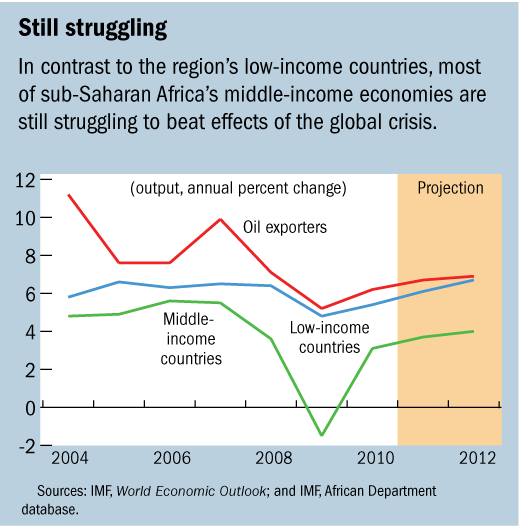
Typical street scene in Santa Ana, El Salvador. (Photo: iStock)
IMF Survey: Africa's Low-income Countries Lead Growth Forecast
May 3, 2011
- More strong growth ahead for most sub-Saharan African low-income countries
- Inflation set to rise as global food, fuel prices surge, growth strengthens
- Time ripe to tackle high fiscal deficits, overly accommodative monetary policies
Another year of strong growth is in prospect for most of the 29 low-income countries in sub-Saharan Africa.

Supermarket in Nairobi, Kenya. Surge in global food, fuel prices is nudging up inflation rates across sub-Saharan Africa (IMF photo)
REGIONAL ECONOMIC OUTLOOK
The IMF’s latest Regional Economic Outlook projects that these countries’ output will expand on average by 6 percent in 2011, compared with last year’s 5½ percent pace.
This performance would be on a par with the region’s high-growth surge in the mid-2000s. The main engines of the low-income countries’ expansion are expected to be exports and private consumption, with the public sector taking more of a back seat.
The omens are good also for oil-exporting countries. Booming oil revenues are already filtering through to many non-oil sectors and easing government financing constraints. A big question is whether governments will be able to exercise sufficient control over government spending to prevent boom-bust cycles.
As always, however, there are risks to growth. What is good for oil exporters may depress real incomes and subdue activity in oil importers. Furthermore, lingering uncertainties in the global outlook and a heavy election calendar in Africa could impinge on growth prospects.
Some countries lag
In contrast to the buoyant low-income countries, most medium-income countries are still struggling to overcome dislocations caused by the global financial crisis (see chart). Within the Southern African Customs Union, recovery from the downturn has generally been at a slower pace than elsewhere in sub-Saharan Africa.

South Africa in particular was hard hit by the global financial crisis. Its recovery and those of many of its middle-income neighbors look set to be gradual, held back by weak demand from Europe and internal dislocation caused by the crisis.
The surge in global food and fuel prices has begun to nudge up consumer price inflation rates across the region. To date there has been considerable variation among countries in the extent of pass-through to domestic prices. In some, inflation has not increased much, reflecting good local harvests. But in several countries, inflation has already increased perceptibly.
Increased income support
In the wake of these developments, the poor in urban areas and landless rural households are set to face increasing difficulties meeting their food and transportation bills. Some countries have introduced price controls to soften the impact. But such broad-brush controls are unlikely to be sustainable because they disrupt markets and produce perverse incentives. Furthermore, subsidies on fuel can be very expensive and ineffective in helping the poor.
The outlook notes however that there are ways of targeting support that provide cost-effective ways of protecting vulnerable families against food price increases. Selective tax reductions or subsidies on food items primarily consumed by the poor are one route. Another is to provide direct income support .The report supports high priority being given in the coming months to establishing such safety nets.
Fiscal deficits need attention
Although fiscal deficits in low-income countries are beginning to decline since their crisis-induced rise, the outlook demonstrates that this mainly reflects resurgence in tax revenues. For the most part, government spending is still growing a little faster than output. While not an immoderate trend in the context of expanding economies, in some countries this is hindering attempts in the short term to rebuild fiscal buffers depleted in the wake of the global recession.
The report urges faster fiscal consolidation in low-income countries that are growing at close to potential and where government debt is already high. Here, fiscal policy needs to focus on medium-term considerations —debt sustainability, improving spending composition, and restoring fiscal space— and on finding room to help vulnerable households affected by higher food prices. Similar paths need to be followed in those middle-income countries where tax revenues are likely to remain constrained for an extended period.
Tighter monetary policy
While an accommodative monetary stance provided useful support to private sector activity across the region during the global recession, strong growth and rising inflation mean that monetary authorities now need to get ahead of the curve. Where food and fuel price increases are pronounced, monetary policy should accommodate their immediate impact on the economy but lean against any further pass-through.
Partly because of low interest rates and bond yields, and associated perceptions of exchange rate risk, portfolio inflows to the region’s frontier markets have been slow to resume since the global financial turmoil of 2008/09. Nevertheless, as Chapter 2 of the outlook reports, many sub-Saharan African frontier economic markets exhibit strong fundamentals relative to other regions. Policies will therefore need to be prepared for renewed inflows.


